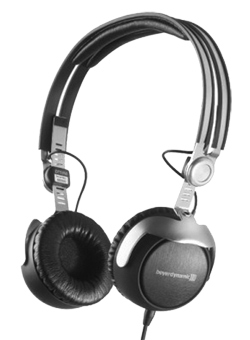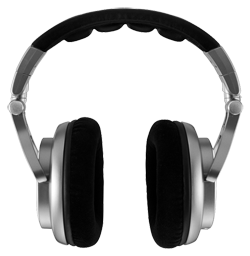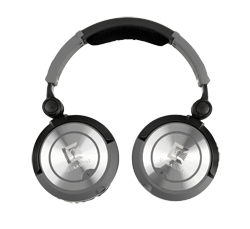by Steve Cunningham
For me, buying another pair of headphones has always been something of a non-event. I buy headphones and blue jeans the same way -- out of habit. I’ve found a brand and style of jeans that I like; they look good, don’t fall apart, and are comfortable. When I need another pair I buy the same thing. So when the last pair of longstanding favorite AKG K-240 headphones (the regular 240 model, not the “Studio” or “MKII” versions) finally gave up the ghost, it was time to go shopping. This month I’ll tell you what I found.
Considering that I’ve been listening to the same model of headphones for the past 25 years, I sought the help of a friend who works at a Famous Music Store to get a few current models to evaluate. These cans are all marketed as studio phones, and do not come with a celebrity endorsement. I have listened to some of the recent crop of celebrity-endorsed headphones -- they were uniformly bad with sloppy, overhyped bass -- which I find not suitable for production work. Of those I tried, the most interesting were the beyerdynamic DT 1350 Professional Headphones, the Ultrasone Pro 750s, and Shure’s SRH940. Here’s how they stack up.
 BEYERDYNAMIC DT 1350
BEYERDYNAMIC DT 1350
I’ve never owned a pair of Beyerdynamic cans, and can’t recall the last time I used a pair in a voiceover studio. Nevertheless, the company has been a legitimate competitor to Sennheiser and others for a very long time.
In 2009, beyerdynamic (yes, that’s the way they like their corporate name printed) introduced their so-called Tesla sound transducers, which utilize a metal-cased ring in place of the traditional neodymium magnet to distribute audio energy throughout a membrane positioned “to minimize disruptive vibrations”, whatever that means. They used this technology in their DT 1350 headphones, a portable closed-back model designed for studio use.
The closed-back DT 1350s are “supra-aural” meaning the ear cups sit on the ear, rather than enclosing the ear. The dual head bands hold the phones more aggressively than you might expect, especially when you separate the two bands, which aids in isolation. Two brushed-metal cups swivel for comfort and flexibility, although they do not fold up for travel. They are capable of sufficiently high volume (109 SPL nominal/129 SPL max) for use even in noisy environments (thanks, I’ll keep mine well below those limits, even if they are good at blocking out external noises). Their rated frequency response is from 5 - 30,000 Hz and with an impedance of 80 ohms they can handle a beefy power amplifier.
These are not bass-heavy headphones, which is not to say they lack bass. They do have less than my AKGs, but their low bass is tight and controlled, like acoustic suspension speakers, and I rather liked that. Actually I was pleasantly surprised with the sound quality all around, especially with the midrange which is highly detailed, although it can become a bit too forward with some guitar-oriented material, but it’s very good for voice tracks, and the transient response on these cans are quick. Rhythmic elements like snares are crisp and quick.
Overall the DT 1350s are well suited for tracking and for mixing. While they are quite full-ranged, the midrange detail reminds me of my beloved Yamaha NS-10s, which have never lied to me about this critical area of response. My only quibble with these is the supra-aural design that sits on my ears. The pads are soft and comfortable enough, but I’m just not used to wearing headphones that sit like the DT 1350s do. I suspect I’d get used to them after a while, and they are the lightest phones of the three evaluated here at just under six ounces. In any case, their sound made them hard to give back.
The DT 1350s carry a suggested US retail price of $379.00, but can commonly be found on the street for less than $300, sometimes much less. For more info visit www.beyerdynamic.com.
 SHURE SRH940
SHURE SRH940
Shure are better known for their microphones than for the small speakers that occupy the earpieces in these cans, but the two-year old SRH series of professional headphones may well change that. The SRH840 was the original top of the line model and it is still available, but the new SRH940 Professional Reference Headphones are the current top dog. Designed for studio use and critical listening, these phones promise “accurate response across the entire audio spectrum, smooth high-end extension, [and] tight bass”. Just what one would expect from a marketing brochure, but the proof is in the wearing and listening, isn’t it?
The SRH940s ship in a padded case, and both cable and ear pads are detachable and replaceable. Included are spare ear pads and a choice of straight or curly cables. These terminate in a 3.5 mm mini‑jack with a screw thread to accept a threaded 1/4” phone adapter (included), while the other end uses a smaller, 2.5mm mini‑jack with a plastic barrel that twists half a turn to lock into place. The phones themselves appear to be solidly built from a firm grey plastic, and the frame and earpiece mountings incorporate plenty of flexibility, allowing the cups to be rotated in every direction, making travel with them a snap.
The construction results in the cups generating slightly more pressure on and around my ears than my AKGs, but they are well padded and comfortable, and unlike my AKGs these did not make me sweat during long sessions. This pressure also ensures that isolation from external sounds is acceptable, although not as good as the DT 1350s mentioned above, and not quite as good as what I expect from closed-back phones. The only discomfort came from the top band, which feels as if it puts the entire weight of the cans on a small area on my head instead of spreading it out; that may have had as much to do with the geography of my head as with the design of these phones, although their 11 ounce weight didn’t help much. With an impedance rated at 42 ohms and a sensitivity of 100dB SPL/mW, the SRH940s shouldn’t require any sort of esoteric headphone amp to drive them.
The SRH940s are definitely punchy, with an upper midrange boost in the area between 1kHz and 3kHz. Rock and pop have an appropriate level of excitement and, more importantly, various undesirable mouth noises are evident and easy to find. Transients are well articulated, and the high frequencies seem nicely balanced overall.
The bass is arguably a bit too tight for some promo work. Imaging with significant low end booms came out feeling lighter than what I am accustomed to, and I was concerned about how the lows might translate on loudspeakers. It’s not that bass and low mids are missing or inaccurate; it’s just that they are overshadowed by that prominent mid-range, in a way that sometimes robs them of ‘oomph’. If you are looking to have your stingers bump you in your seat, then these are not the phones for you.
Having said that, for most studio uses I think the frequency balance of these phones, with its absence of hype at the low end, are probably more a blessing than a curse. As we know, imaging and commercials live or die on mid-range, where the sales message lives, and you quickly appreciate the detail and clarity that these phones bring to that region. After a lot of listening, I even began to feel that my beloved AKGs were sounding muddy by comparison.
The Shure SRH940s carry a suggested retail price in the US of $375, with a street price in the low- to mid-$200s. For more information, visit www.shure.com.
 ULTRASONE PRO 750
ULTRASONE PRO 750
Like any respectable headphone manufacturer, Ultrasone claim to have unique technologies that make their headphones superior to their competitors. In their case, that feature is labeled ‘S‑Logic’, which is supposed to make the experience of listening on phones more like listening on loudspeakers. This isn’t a form of digital processing, but refers to the physical geometry of the phones themselves.
If you’re used to typical studio phones, the first thing you notice when you put on the Pro 750s is that the ring‑shaped cushions around the edge are much deeper than usual. They still form a seal around the ear, but position the actual drivers quite a bit further from your head than do standard phones. The ear cups themselves incorporate complex baffles which, according to Ultrasone, “decentralize the sound”. So instead of the drivers firing directly into your inner ear, the sounds are reflected into the inner ear from the outer, in an effort to mimic the way sound arrives from loudspeakers. Ultrasone describe S‑Logic as generating “natural surround sound”, and also claim a side benefit of reducing the risk of hearing damage. All in all it’s quite a marketing story; forgive me, but all that’s missing is a collie and a little girl stuck in a well.
That aside, the design of the Pro 750s sticks pretty closely to what most of us consider as good headphone design. The cable is detachable, and screws into the base of the left earpiece. Two cables are included: an annoyingly short, straight one with a mini‑jack, and a longer curly one with a full‑sized connector. A nice touch is that the Pro 750s ship in a padded case with a spare pair of ear cushions. The phones themselves are made out of reasonably heavy‑duty plastic, are easy to adjust to fit your dome, and weigh in at about 10.4 ounces. They’re also reasonably comfortable in use, although because the drivers sit so far from your head, there’s less isolation from external sounds than with most closed‑back phones. The specs list their impedance as 40 ohms, and although they are a fair bit less sensitive than my usual AKGs, any headphone amp worth its salt will have no trouble driving them.
The Pro 750s present a frequency balance that is very bright, with a response of 8Hz to 35kHz and a sizable bump in the upper mids, though some initial harshness was tamed once the headphones had been burned in for a while. The bass end of things is strong, with somewhat of a dip in the lower mid‑range. Their brightness makes the Pro 750s highlight transient detail, but also they also tend to exaggerate sibilance. In this case my concern was how the brightness of the high end would translate, and whether extra care would be needed to tame sibilance.
Still, I did not become fatigued when working with the Pro 750s. This may be a side benefit of the S‑Logic technology or it may not, and I still find the whole S-Logic straining credibility, but S‑Logic does make a difference to the experience of listening on headphones. It’s often very subtle, but I did sense a sense of spatial separation between individual sources that doesn’t normally exist with conventional closed‑back designs. In no way did I believe I was listening to loudspeakers, but I did feel the center-panned sounds were coming from in front of me rather than from inside the middle of my head (which is somewhat vacant anyway, right?). It’s not a dramatic effect, but there is something different there. If you spend a lot of time listening to and creating production material on headphones, these bear an audition.
The Ultrasone PRO 750 Professional Headphones carry a US retail price of $409, with street prices in the mid-$200 range. For more information, visit www.ultrasone.com.
WRAP ‘EM UP
I’m still not quite ready to pull the trigger on a new pair of cans, although I definitely enjoyed the experience. I may try yet again to repair a pair I have, or Frankenstein together one good pair from carcasses; they just don’t make ‘em like they used to. I am tempted by the beyerdynamic cans, provided I can deal with the fitment, but it looks like it’s back to the Famous Music Store with these. Perhaps I’ll bring home another batch.
♦

